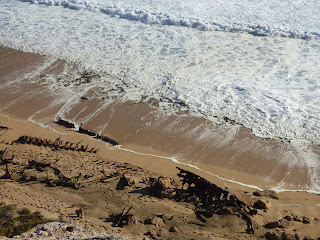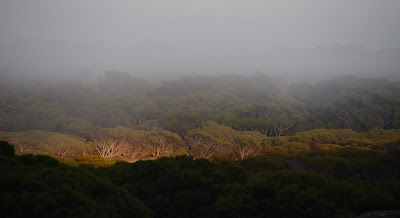Our first stop was Ardrossan, around three hours from home. It's a sea port and agricultural centre on the east coast. What caught my eye here was the stump-jump plough in the park overlooking the Gulf St Vincent. I suppose this seems a strange object to get excited about but I can vividly remember learning about this in primary school as it was a huge farming advancement in the 19th century - and I loved the sound of its name. I had no idea it was developed locally and in the best tradition of inventions - a bolt fell off a plough blade and instead of the plough veering off course, it ploughed straight on over the mallee roots - hence its name!
 |
| The stump-jump plough |
 |
| Love this shot of squawking seagulls. |
 |
| A mural depicts the seafaring and agricultural heritage of Ardrossan. |
 |
| Despite the dry and hot conditions on the Peninsula everyone seemed to take care of their gardens. |
 |
| A typical house built of the local sandstone. |
 |
| I have a soft spot for 1950s-style homes. |
 |
| The tides on the Peninsula are extensive, so much so that it was often difficult to see the sea! |
 |
| Port Vincent is typical of many South Australian coastal towns. The tide was well and truly in when I took this photo in the early evening. |
Close to sundown, we wandered along the beach with the tide still way out.
And I'm a sucker for Mr Percivals.
We had a cabin right on the water. At last, the tide came in.
I am always interested in the Institutes that were such an important part of town life in the 19th century, providing a library, concerts and a gathering place for locals. Here is Port Vincent's.
Then it was off to visit some inland towns. The extensive wheat, barley and canola crops had all been reduced to stubble so the roadside scenery was of vast flat fields of nothing.
I am always interested in the Institutes that were such an important part of town life in the 19th century, providing a library, concerts and a gathering place for locals. Here is Port Vincent's.
Then it was off to visit some inland towns. The extensive wheat, barley and canola crops had all been reduced to stubble so the roadside scenery was of vast flat fields of nothing.
We encountered a fauna park .. and a headless emu!
This is Minlaton, right in the centre of the Yorke Peninsula, self-titled as the Barley Capital of the World.Here we saw the Red Devil, a 1916 Bristol monoplane, the only one of its kind left in the world. It was flown by Harry Butler, a Minlaton lad and a Word War I pilot. He made the first over-water flight in the Southern Hemisphere when he flew an airmail flight from Adelaide across Gulf St Vincent to Minlaton in 1919 in this plane.
We really enjoyed a walking trail that took us through the town ...
down a grove of sheoaks ...
past the Gum Flat Run homestead with its old horse dip that was used to control parasites in the Clydesdales ...
... a small stand of the only remaining red gums on the Yorke Peninsula ...
.. and two Aboriginal wells (now fenced off) from which the town got its name: minlacowie meaning sweet water. The next stop, Yorketown, had super wide streets, pretty gardens, numerous salt lakes...
... and an Institute.
There was a lovely park full of native plants with signs explaining their uses, and lots of small artwork lining a walkway round the lake. The following photo shows a dry river bed leading to the lake; I liked the rock turtle.
Next morning it was off to the Innes National Park at the tip of the peninsula, driving past vast paddocks of dried stubble stretching to the wide, flat horizon.
On the way we came across this deserted building which seemed to personify the harsh life the early pioneers encountered.
First stop was Edithburg, a town full of fine old buildings and historical mementos of its colourful past.
 |
| The anchor of the steamer Clan Ranald that was wrecked near here in 1909 with much loss of life. |
We had booked the old Post Office situated within the park in the abandoned town of Inneston, a once-thriving community in the early 1900s based on gypsum mining. The Post Office is the building on the left.
There was an interpretive walk around the ghost town indicating the uses of the now-ruined buildings and a track which led down to a lake. None of the other restored accommodation was booked so we had the place to ourselves.

There was an interpretive walk around the ghost town indicating the uses of the now-ruined buildings and a track which led down to a lake. None of the other restored accommodation was booked so we had the place to ourselves.

A by-product of gypsum is chalk, and nearby was the ruins of the Bellco chalk factory which supplied chalk to schools throughout Australia in the 1960s and 70s; I remember well the cardboard box with the long white and coloured chalk sticks - and to think they were made right here!
| Source: thepropstore.com.au |
In the afternoon we drove to Ethel Beach. Here were the remains of the wreck of the Ethel which ran aground in 1904.


The next day we explored the beaches and did a fabulous coastal walk.
 |
| Pondalowie Beach |
We then walked to the surf beach.
 |
| Pondalowie surf beach |
 |
| Remnants of the train that carried gypsum to the jetty. |
Here I am coming back from viewing Cape Spencer lighthouse, situated at the very bottom tip of Yorke Peninsula.
Nearby were gorgeous little coves carved out of the limestone by the constant surging waves.
Sunset at the lake near our accommodation was breathtaking.
We then drove north to what the brochures refer to as the Copper Coast - three towns that owe their existence to copper discovered there in 1860. Scores of miners from Cornwall arrived and the towns mined, smelted and delivered copper to the world.
Moonta was our favourite as it has kept many of the old buildings and there seemed a genuine spirit of the past.
 |
| A miner's cottage. |
I made sure I bought the specialty of the region - a Cornish pasty!

Wallaroo, too, had its share of old buildings but modern development made the town feel a bit disjointed.


Wallaroo, too, had its share of old buildings but modern development made the town feel a bit disjointed.

We did enjoy the Nautical Museum, loaded with maritime memorabilia as well as artefacts covering the town's social history, postal and communications developments and entertainment. All fascinating though it was a bit disconcerting to see a display of knuckle bones with a caption 'Games from Yesteryear'!!!! I clearly remember that Mum would collect the bones from a roast, clean and dry them, and then we played games with them at primary school. We reckoned that the real bones were much better than the plastic ones.


























































